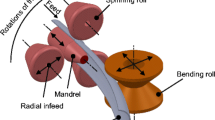Abstract
As an emerging flexible manufacturing technology, incremental forming of tubes has the ability to produce various tubular parts, including those that are difficult to integrally form using other methods. Due to the nature of hollow and thin-walled geometry, the deformation mechanism in the incremental forming of tubes is quite different from that of conventional incremental forming of sheets. This paper summarizes a list of typical tubing that can be formed incrementally and then examines the processes used to form four types of tubular parts, including axisymmetric expansion/reduction of tube ends, tube wall grooving, and hole flanging. This is done primarily from the perspective of phenomenology by using experiments and numerical simulation. Typical deformation behaviors of the workpieces were revealed and discussed. Three basic deformation modes in terms of variations in wall thickness, namely thinning (such as in end expansion), thickening (such as in end reduction), and invariant or almost constant thickness (such as in part of the wall grooving), were found to exist during incremental tube forming. Regarding the formability limits of the tube, incremental forming has its own advantages and disadvantages when compared with pressing.
Similar content being viewed by others
References
Green DE, Angara TS, Nurcheshmeh M, Wormald T (2012) A practical method to evaluate the forming severity of tubular hydroformed parts. Int J Adv Manuf Technol 62(9–12):965–980
Hashmi MSJ (2006) Aspects of tube and pipe manufacturing processes: meter to nanometer diameter. J Mater Process Tech 179:5–10
Tabatabaei SA, Shariat PM, Mosavi MM, Tabatabee SM, Aghajanzadeh M (2013) Optimum design of preform geometry and forming pressure in tube hydroforming using the equi-potential lines method. Int J Adv Manuf Technol 69(9–12):2787–2792
Allwood JM, Utsunomiya H (2006) A survey of flexible forming processes in Japan. Int J Mach Tool Manu 46(15):1939–1960
Alves LM, Dias EJ, Martins PAF (2011) Joining sheet panels to thin-walled tubular profiles by tube end forming. J Clean Prod 19(6–7):712–719
Yang H, Li H, Zhang ZY, Zhan M, Liu J, Li GJ (2012) Advances and trends on tube bending forming technologies. Chinese J Aeronaut 25(1):1–12
Wen T (2014) On a new concept of rotary draw bend-die adaptable for bending tubes with multiple outer diameters under non-mandrel condition. J Mater Process Tech 214(2):311–317
Hsieh HS, Lin J (2005) Study of the buckling mechanism in laser tube forming with axial preloads. Int J Mach Tool Manu 45(12–13):1368–1374
Emmens WC, Sebastiani G, Boogaard AH (2010) The technology of incremental sheet forming—a brief review of the history. J Mater Process Tech 210(8):981–997
Zhang C, Xiao HF, Yu DH (2013) Incremental forming path-generated method based on the intermediate models of bulging simulation. Int J Adv Manuf Technol 67(9–12):2837–2844
Ambrogio G, Filice L, Gagliardi F (2012) Improving industrial suitability of incremental sheet forming process. Int J Adv Manuf Technol 58(9–12):941–947
Matsubara S (1994) Incremental nosing of a circular tube with a hemispherical head tool. J JSTP 35:256–261
Teramae T, Manabe K, Ueno K, Nakamura K, Takeda H (2007) Effect of material properties on deformation behavior in incremental tube-burring process using a bar tool. J Mater Process Tech 191(1–3):24–29
Wen T, Yang C, Chen X (2013) A method for producing special-shaped tubular parts based on dieless NC incremental forming process. Chinese patent, 201310005922.7
Jackson K, Allwood JM (2009) The mechanics of incremental sheet forming. J Mater Process Tech 209(3):1158–1174
Yao J, Murata M (2005) An experimental study on spinning of taper shape on tube end. J Mater Process Tech 166(3):405–410
Almeida BPP, Alves LM, Rosa PAR, Brito AG, Martins PAF (2006) Expansion and reduction of thin-walled tubes using a die: experimental and theoretical investigation. Int J Mach Tool Manu 46(12–13):1643–1652
Lu YH (2003) Study of tube flaring ratio and strain rate in the tube flaring process. Finite Elem Anal Des 40(3):305–318
Leu DK (2000) The curling characteristics of static inside-out inversion of metal tubes. Int J Mach Tool Manu 40(1):65–80
Rathinam N, Prabu B (2013) Static buckling analysis of thin cylindrical shell with centrally located dent under uniform lateral pressure. Int J Steel Struct 13(3):509–518
Vasilikis D, Karamanos SA (2009) Stability of confined thin-walled steel cylinders under external pressure. Int J Mech Sci 51(1):21–32
Li H, Yang H, Song FF, Zhan M, Li GJ (2012) Springback characterization and behaviors of high-strength Ti–3Al–2.5V tube in cold rotary draw bending. J Mater Process Tech 212(9):1973–1987
Miller G (2003) Tube forming processes: a comprehensive guide. SME, Dearborn
Orynyak IV, Radchenko SA (2007) Analytical and numerical solution for a elastic pipe bend at in-plane bending with consideration for the end effect. Int J Solids Struct 44(5):1488–1510
Moshksar MM, Borji S (1994) End effect in the explosive forming of tubes. J Mater Process Tech 42(4):431–441
Yang C, Wen T, Liu LT, Zhang S, Wang H (2014) Dieless incremental hole-flanging of thin-walled tube for producing branched tubing. J Mater Process Tech 214(11):2461–2467
Centeno G, Silva MB, Cristino VAM, Vallellano C, Martins PAF (2012) Hole-flanging by incremental sheet forming. Int J Mach Tool Manu 59:46–54
Author information
Authors and Affiliations
Corresponding author
Rights and permissions
About this article
Cite this article
Wen, T., Yang, C., Zhang, S. et al. Characterization of deformation behavior of thin-walled tubes during incremental forming: a study with selected examples. Int J Adv Manuf Technol 78, 1769–1780 (2015). https://doi.org/10.1007/s00170-014-6777-4
Received:
Accepted:
Published:
Issue Date:
DOI: https://doi.org/10.1007/s00170-014-6777-4




